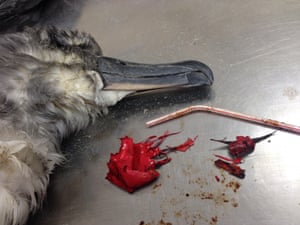How worried should we be about microplastics?
Article from: The Guardian
Author: Graham Readferan
If you enjoy a spot of food, like to breathe air and partake in the occasional drink of water (tap or bottled), then you’re almost certainly an unwitting consumer of microplastics.
People who use triangular nylon tea bags are the latest group to be shocked at their exposure to plastics. According to one study, they could be getting about 11bn or so particles of plastic with their Earl Grey or breakfast tea.
Microplastics have turned up pretty much everywhere that scientists have looked for them – from the bottom of the deepest parts of our oceans to the stomachs of whales, seabirds and in our own poo.
But should we be worried about our plastic diet – either for the sake of our own health or for the health of the environment?
What is microplastic?
There’s no agreed definition, but researchers have generally referred to pieces of plastic smaller than about 5mm as microplastic. However, the University of New South Wales’s Mark Browne, who has been researching plastics since 2004, says it’s better to think about plastics relative to the units they’re measured in. So microplastics are between one micrometre and 1,000 micrometres wide (there are 1,000 micrometres in one millimetre).
There’s also an emerging field of research looking at nanoplastics – pieces too small to see with the naked eye – which are measured in nanometres (there are 1,000 nanometres in one micrometre).
What’s important to remember is that the larger pieces of plastic that can entangle wildlife end up in the stomachs of animals and litter our coastlines will in many cases become the microplastics of tomorrow.
What is it doing to our health?
“There’s an absence of science here,” says Browne. “We know that across particle sizes, plastics can cause issues. The critical issue now is what are the concentrations that people and wildlife are being exposed to. We don’t need more studies on which products emit plastics. We need studies that expose organisms or models to these doses to see if they cause problems.”
Environmental scientist Kevin Thomas, director of the Queensland Alliance for Environmental Health Sciences, is researching the different ways our bodies are being exposed to plastics.
He says there is evidence that nanoparticles, not necessarily derived from plastics, can cause our immune system to respond at a cellular level.
What is it doing to our health?
“There’s an absence of science here,” says Browne. “We know that across particle sizes, plastics can cause issues. The critical issue now is what are the concentrations that people and wildlife are being exposed to. We don’t need more studies on which products emit plastics. We need studies that expose organisms or models to these doses to see if they cause problems.”
Environmental scientist Kevin Thomas, director of the Queensland Alliance for Environmental Health Sciences, is researching the different ways our bodies are being exposed to plastics.
He says there is evidence that nanoparticles, not necessarily derived from plastics, can cause our immune system to respond at a cellular level.
Thomas thinks if there is a potential for plastics to harm us, it will be once they have been reduced to those tiny “nano-sized” pieces that could pass through the wall of the gut.
Unfortunately, he says, those particles are so small they’re very hard to measure.
So what does his gut tell him about the potential for harm from microplastics?
“It’s a very tough question,” says Thomas. “Personally, I think there’s little risk to our health based on what we know ... but then, who knows what we might find in the future.
“I eat seafood, for example, but I don’t use plastic chopping boards at home.
“But I would advocate avoiding plastics and reducing our reliance on them. Releasing plastics into our environment like we are is unacceptable.”
Browne says he has sympathy for the public, who just want answers. “My suggestion is that we need to be managing and reducing our exposure to these polymers and plastics. There’s enough evidence of harm that we should be doing that.”
What about the environment?
There are wide-ranging concerns about the impacts of microplastics on our environment, in particular on our marine wildlife. But as with impacts on humans, it is a challenge for scientists to tease out the impacts of microplastics from all the other things that animals are exposed to.
Lauren Roman, at CSIRO oceans and atmosphere, says that for all animals “the size of the plastic matters”.
“If the piece is too big, the animal won’t eat it or, in the case of seabirds, they will regurgitate it. If it’s very small then it can just pass straight through them.”
For larger pieces, Roman says there is some evidence that plastic accumulating in the stomachs of animals can suppress their appetite – known as the “dietary dilution effect” that could have knock-on effects.

A dead shearwater bird with a plastic straw and pieces of a red balloon that were found inside of it on North Stradbroke Island, Queensland. Photograph: Denise Hardesty/AP
Roman says while chemicals associated with the plastics – such as pthalates and brominated flame retardants – have been detected in the tissues of animals, “we don’t know yet if they are affecting the health of the animal”.
Around the world, researchers are only now beginning to examine the impacts of plastics on the health of animals, after a swathe of studies identified the many species that were interacting with microplastics.
“But we should definitely be concerned,” Roman says. “For seabirds, we have these pieces smaller than 5mm getting stuck in the gut and causing death. And all the very big pieces will break up into smaller ones.
“The fact that nothing serious has been found yet suggests to me that we must be looking for small effects and, remember, that we are exposed to lots of things in our lives. Is this something to get our knickers in a knot about? I’m not sure.”What should we do?The experts the Guardian spoke to agreed a wise step here is to reduce our use and exposure to plastics. From an environmental perspective, campaigners say we should be cutting out unnecessary plastic use, including single-use items, and substituting plastics where we can.
But Browne also had words of caution. “If we are going to do that, we should make sure that as we intercept or redesign products we don’t cause more problems,” he says.
“Remembering that some asbestos was used in clothing – it’s a natural fibre but it causes all sorts of serious issues for people.”


